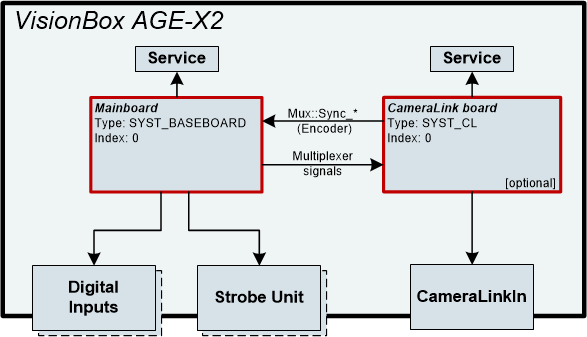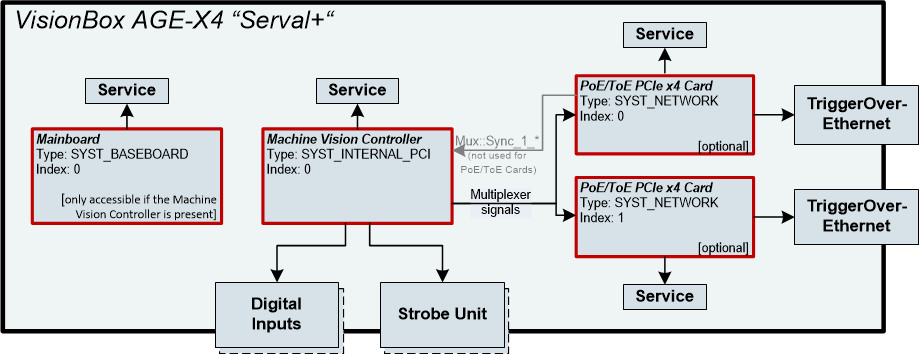The class VIBSystem can be used as the factory for Devices.
A VIBSystem object is associated with a specific hardware component like the mainboard or an extension card.
The factory is created by calling one of the following static functions:
After the factory instance is created, the device object can be opened by using one of the OpenDevice() methods:
The method VIBSystem::CloseDevice() closes and deletes the device object again.
The static function VIBSystem::DeleteInstance() finally closes and deletes the factory.
Example:
The following table lists the supported hardware components and associated hardware types and system types:
| Platform | Hardware component | eHardwareType | eSystemType |
|---|---|---|---|
| VisionBox AGE-X1 | Mainboard with RTCC | HWT_AGEX | SYST_BASEBOARD |
| VisionBox AGE-X2 | Mainboard with RTCC | HWT_AGEX2 | SYST_BASEBOARD |
| Smart NIC | HWT_AGEX2_POETOE | SYST_NETWORK | |
| Camera Link | HWT_AGEX2_CL | SYST_CL | |
| VisionBox AGE-X3 | I/O board with RTCC | HWT_AGEX3 | SYST_BASEBOARD |
| VisionBox AGE-X4[1] | Mainboard without RTCC | HWT_AGEX4 | SYST_BASEBOARD |
| VisionBox AGE-X5 | Mainboard with RTCC | HWT_AGEX5 | SYST_BASEBOARD |
| Smart NIC | HWT_AGEX5_POETOE | SYST_NETWORK | |
| Camera Link | HWT_AGEX5_CL | SYST_CL | |
| VisionBox AGE-X6 | Mainboard with RTCC | HWT_AGEX6 | SYST_BASEBOARD |
| Smart NIC | HWT_AGEX6_POETOE | SYST_NETWORK | |
| Camera Link | HWT_AGEX6_CL | SYST_CL | |
| VisionBox LE MANS [1] | Mainboard with RTCC | HWT_LEMANS | SYST_BASEBOARD |
| VisionBox DAYTONA | Mainboard with RTCC | HWT_DAYTONA | SYST_BASEBOARD |
| VisionBox AI | Mainboard with RTCC | HWT_AI | SYST_BASEBOARD |
| VisionBoards (PCIe cards) | Machine Vision Controller (RTCC) | HWT_MVC0 | SYST_INTERNAL_PCI |
| Smart NIC | HWT_PCIE_POETOE | SYST_NETWORK | |
| Camera Link card | HWT_PCIE_CL | SYST_CL | |
| VisionCam XM | Camera with RTCC | HWT_VCXM | SYST_BASEBOARD |
| VisionCam XM2 | Camera with RTCC | HWT_VCXM2 | SYST_BASEBOARD |
| VisionSensor PV (1/2) | Camera without RTCC | HWT_VSPV | SYST_BASEBOARD |
| VisionSensor PV3 | Camera without RTCC | HWT_VSPV3 | SYST_BASEBOARD |
| VisionSensor PV3 + I/O Expansion | Camera with external RTCC | ||
| Machine Vision Manager 1 | USB device with RTCC | HWT_MVM0 | SYST_EXTERNAL_USB |
| Machine Vision Manager 2 | USB device with RTCC | HWT_MVM2 | SYST_EXTERNAL_USB |
The factory hides any hardware related implementation details. Therefore, the same programming interface can be used with different hardware platforms and operating systems. To enable generic applications, the available devices can be determined at runtime by calling GetDeviceInfo().
Each hardware component can provide multiple devices of the same type and each device can have multiple I/O channels.
For example, the VisionBox AGE-X1 has a single CameraTrigger device which controls two output channels.
The VisionBox AGE-X2 "Tiger" has four CameraTrigger devices, but each device has only one output channel.
The number of channels can be requested with CameraTrigger::GetNumberOfOutputs() or similar member functions for other devices.
The following image shows the internal structure of the VisionBox AGE-X2 with a Camera Link interface:

Most devices are controlled by the mainboard component (SYST_BASEBOARD) which provides the RTCC (FPGA).
The VisionBox additionally includes a Camera Link card. In order to use the CameraLinkIn device, the VIBSystem factory has to be created with the system type SYST_CL.
Also note that the Multiplexer signals are also available to the Camera Link card as signal source for CameraLinkIn::ConfigureCC().
In the opposite direction, the RS-422 input signals are sent to the main FPGA as source for the Multiplexer or other devices.
The following example shows a VisionBox AGEX-4 with three PCIe cards: one Machine Vision Controller and two PoE/ToE cards:

This hardware configuration has four hardware entities. Please note that the mainboard only has a Service device, most devices are controlled by the Machine Vision Controller (SYST_INTERNAL_PCI).
Classes | |
| class | VIB::VIBSystem |
| The factory for devices. More... | |